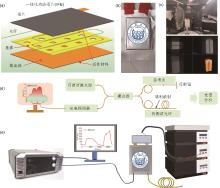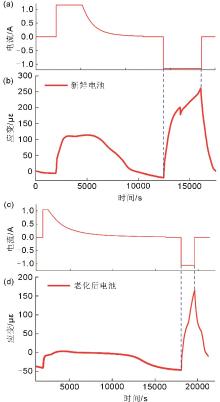Energy Storage Science and Technology ›› 2024, Vol. 13 ›› Issue (11): 4113-4123.doi: 10.19799/j.cnki.2095-4239.2024.0435
• Energy Storage Test: Methods and Evaluation • Previous Articles Next Articles
Xiuwu WANG1( ), Jiangong ZHU1, Dengcheng LIU2, Wanqiang FENG2,3, Shuiping ZHAO3, Haonan LIU1, Haifeng DAI1, Xuezhe WEI1(
), Jiangong ZHU1, Dengcheng LIU2, Wanqiang FENG2,3, Shuiping ZHAO3, Haonan LIU1, Haifeng DAI1, Xuezhe WEI1( )
)
Received:2024-05-16
Revised:2024-05-28
Online:2024-11-28
Published:2024-11-27
Contact:
Xuezhe WEI
E-mail:2010854@tongji.edu.cn;weixzh@tongji.edu.cn
CLC Number:
Xiuwu WANG, Jiangong ZHU, Dengcheng LIU, Wanqiang FENG, Shuiping ZHAO, Haonan LIU, Haifeng DAI, Xuezhe WEI. Non-destructive monitoring and evolutionary characterization of internal temperature in lithium-ion batteries[J]. Energy Storage Science and Technology, 2024, 13(11): 4113-4123.

Fig. 1
The pouch cell with an integrated functional electrode (IFE), the principle of temperature monitoring and the experimental set-up for the cell. (a) Schematic diagram of the IFE; (b) Photograph of the pouch cell; (c) Cross-section X-ray image of the pouch cell with IFE; (d) Schematic diagram of the optical fiber sensor which use the OFDR technology; (e) Battery in-situ temperature test platform"


Fig. 9
The correlation between current and strain of the highest temperature position within the IFE during the 1C cycling (a) Current curve of the battery before aging; (b) Fiber strain profile at BoL of the battery; (c) Current curve of the battery after aging; (b) Fiber strain profile at EoL of the battery"

| 1 | ZHU J G, WANG Y X, HUANG Y, et al. Data-driven capacity estimation of commercial lithium-ion batteries from voltage relaxation[J]. Nature Communications, 2022, 13(1): 2261. DOI: 10.1038/s41467-022-29837-w. |
| 2 | JUNG H G, JANG M W, HASSOUN J, et al. A high-rate long-life Li4Ti5O12/Li[Ni0.45Co0.1Mn1.45]O4 lithium-ion battery[J]. Nature Communications, 2011, 2: 516. DOI: 10.1038/ncomms1527. |
| 3 | WANG X W, ZHU J G, DAI H F, et al. Impedance investigation of silicon/graphite anode during cycling[J]. Batteries, 2023, 9(5): 242. DOI: 10.3390/batteries9050242. |
| 4 | DING S C, LI Y D, DAI H F, et al. Accurate model parameter identification to boost precise aging prediction of lithium-ion batteries: A review[J]. Advanced Energy Materials, 2023, 13(39): 2301452. DOI: 10.1002/aenm.202301452. |
| 5 | FENG X N, REN D S, HE X M, et al. Mitigating thermal runaway of lithium-ion batteries[J]. Joule, 2020, 4(4): 743-770. DOI: 10.1016/j.joule.2020.02.010. |
| 6 | HUANG J Q, BOLES S T, TARASCON J M. Sensing as the key to battery lifetime and sustainability[J]. Nature Sustainability, 2022, 5: 194-204. DOI: 10.1038/s41893-022-00859-y. |
| 7 | WEI Z B, ZHAO J Y, HE H W, et al. Future smart battery and management: Advanced sensing from external to embedded multi-dimensional measurement[J]. Journal of Power Sources, 2021, 489: 229462. DOI: 10.1016/j.jpowsour.2021.229462. |
| 8 | FICHTNER M, EDSTRÖM K, AYERBE E, et al. Rechargeable batteries of the future — The state of the art from a BATTERY 2030+ perspective[J]. Advanced Energy Materials, 2022, 12(17): 2102904. DOI: 10.1002/aenm.202102904. |
| 9 | HEENAN T M M, MOMBRINI I, LLEWELLYN A, et al. Mapping internal temperatures during high-rate battery applications[J]. Nature, 2023, 617(7961): 507-512. DOI: 10.1038/s41586-023-05913-z. |
| 10 | LU X B, TARASCON J M, HUANG J Q. Perspective on commercializing smart sensing for batteries[J]. eTransportation, 2022, 14: 100207. DOI: 10.1016/j.etran.2022.100207. |
| 11 | FURAT O, FINEGAN D P, YANG Z Z, et al. Quantifying the impact of operating temperature on cracking in battery electrodes, using super-resolution of microscopy images and stereology[J]. Energy Storage Materials, 2024, 64: 103036. DOI: 10.1016/j.ensm.2023.103036. |
| 12 | STURM J, FRIEDRICH S, GENIES S, et al. Experimental analysis of short-circuit scenarios applied to silicon-graphite/nickel-rich lithium-ion batteries[J]. Journal of the Electrochemical Society, 2022, 169(2): 020569. DOI: 10.1149/1945-7111/ac51f3. |
| 13 | YU Y F, VERGORI E, WORWOOD D, et al. Distribsuted thermal monitoring of lithium ion batteries with optical fibre sensors[J]. Journal of Energy Storage, 2021, 39: 102560. DOI: 10.1016/j.est.2021.102560. |
| 14 | LI Y D, WANG W W, YANG X G, et al. A smart Li-ion battery with self-sensing capabilities for enhanced life and safety[J]. Journal of Power Sources, 2022, 546: 231705. DOI: 10.1016/j.jpowsour.2022.231705. |
| 15 | WANG X W, ZHU J G, WEI X Z, et al. Non-damaged lithium-ion batteries integrated functional electrode for operando temperature sensing[J]. Energy Storage Materials, 2024, 65: 103160. DOI: 10.1016/j.ensm.2023.103160. |
| 16 | MEI W X, LIU Z, WANG C D, et al. Operando monitoring of thermal runaway in commercial lithium-ion cells via advanced lab-on-fiber technologies[J]. Nature Communications, 2023, 14(1): 5251. DOI: 10.1038/s41467-023-40995-3. |
| 17 | HUANG J Q, ALBERO BLANQUER L, BONEFACINO J, et al. operando decoding of chemical and thermal events in commercial Na(Li)-ion cells via optical sensors[J]. Nature Energy, 2020, 5(9): 674-683. DOI: 10.1038/s41560-020-0665-y. |
| 18 | LEE C Y, LEE S J, CHEN Y H, et al. In-situ monitoring of temperature and voltage in lithium-ion battery by embedded flexible micro temperature and voltage sensor[J]. International Journal of Electrochemical Science, 2013, 8(2): 2968-2976. DOI: 10.1016/S1452-3981(23)14365-3. |
| 19 | LEE C Y, LEE S J, TANG M S, et al. In situ monitoring of temperature inside lithium-ion batteries by flexible micro temperature sensors[J]. Sensors, 2011, 11(10): 9942-9950. DOI: 10.3390/s111009942. |
| 20 | YU Y F, VERGORI E, MADDAR F, et al. Real-time monitoring of internal structural deformation and thermal events in lithium-ion cell via embedded distributed optical fibre[J]. Journal of Power Sources, 2022, 521: 230957. DOI: 10.1016/j.jpowsour. 2021.230957. |
| 21 | FLEMING J, AMIETSZAJEW T, CHARMET J, et al. The design and impact of in situ and operando thermal sensing for smart energy storage[J]. Journal of Energy Storage, 2019, 22: 36-43. DOI: 10.1016/j.est.2019.01.026. |
| 22 | WANG X Y, LI R K, DAI H F, et al. A novel dualtime scalelife prediction method for lithium-ion batteries considering effects of temperature and state of charge[J]. International Journal of Energy Research, 2021, 45(10): 14692-14709. DOI: 10.1002/er.6746. |
| 23 | 狄云, 周正柱, 党会鸿, 等. 基于ECM的电芯电-热耦合建模与验证[J]. 储能科学与技术, 2023, 12(8): 2638-2648. DOI: 10.19799/j.cnki.2095-4239.2023.0080. |
| DI Y, ZHOU Z Z, DANG H H, et al. Modeling and verification of electric-thermal coupling in batteries based on ECM[J]. Energy Storage Science and Technology, 2023, 12(8): 2638-2648. DOI: 10.19799/j.cnki.2095-4239.2023.0080. | |
| 24 | WANG X W, WEI K, TAO Y, et al. Thermal protection system integrating graded insulation materials and multilayer ceramic matrix composite cellular sandwich panels[J]. Composite Structures, 2019, 209: 523-534. DOI: 10.1016/j.compstruct. 2018.11.004. |
| 25 | QIN N, JIN L M, XING G G, et al. Decoupling accurate electrochemical behaviors for high-capacity electrodes via reviving three-electrode vehicles[J]. Advanced Energy Materials, 2023, 13(11): 2204077. DOI: 10.1002/aenm.202204077. |
| 26 | 周星. 基于阻抗的锂离子电池动态建模、全频表征与快速诊断[D]. 长沙: 国防科技大学, 2019. DOI: 10.27052/d.cnki.gzjgu. 2019.000410. |
| ZHOU X. Dynamic modeling, full-frequency characterization and rapid diagnosis of lithium-ion battery based on impedance[D]. Changsha: National University of Defense Technology, 2019. DOI: 10.27052/d.cnki.gzjgu.2019.000410. |
| [1] | Zhonglin SUN, Jiabo LI, Di TIAN, Zhixuan WANG, Xiaojing XING. Useful life prediction for lithium-ion batteries based on COA-LSTM and VMD [J]. Energy Storage Science and Technology, 2024, 13(9): 3254-3265. |
| [2] | Jizhong LU, Simin PENG, Xiaoyu LI. State-of-health estimation of lithium-ion batteries based on multifeature analysis and LSTM-XGBoost model [J]. Energy Storage Science and Technology, 2024, 13(9): 2972-2982. |
| [3] | Xuefeng HU, Xianlei CHANG, Xiaoxiao LIU, Wei XU, Wenbin ZHANG. SOC estimation of lithium-ion batteries under multiple temperatures conditions based on MIARUKF algorithm [J]. Energy Storage Science and Technology, 2024, 13(9): 2983-2994. |
| [4] | Siyuan SHEN, Yakun LIU, Donghuang LUO, Yujun LI, Wei HAO. Transient overvoltage protection design and circuit development for energy storage lithium-ion battery modules [J]. Energy Storage Science and Technology, 2024, 13(9): 3277-3286. |
| [5] | Yuan CHEN, Siyuan ZHANG, Yujing CAI, Xiaohe HUANG, Yanzhong LIU. State-of-health estimation of lithium batteries based on polynomial feature extension of the CNN-transformer model [J]. Energy Storage Science and Technology, 2024, 13(9): 2995-3005. |
| [6] | Ruihe XING, Suting WENG, Yejing LI, Jiayi ZHANG, Hao ZHANG, Xuefeng WANG. AI-assisted battery material characterization and data analysis [J]. Energy Storage Science and Technology, 2024, 13(9): 2839-2863. |
| [7] | Hongsheng GUAN, Cheng QIAN, Bo SUN, Yi REN. Predicting capacity degradation trajectory for lithium-ion batteries under limited data conditions [J]. Energy Storage Science and Technology, 2024, 13(9): 3084-3093. |
| [8] | Xue KE, Huawei HONG, Peng ZHENG, Zhicheng LI, Peixiao FAN, Jun YANG, Yuzheng GUO, Chunguang KUAI. Estimating lithium-ion battery health using automatic feature extraction and channel attention mechanisms for multi-timescale modeling [J]. Energy Storage Science and Technology, 2024, 13(9): 3059-3071. |
| [9] | Chengwen TIAN, Bingxiang SUN, Xinze ZHAO, Zhicheng FU, Shichang MA, Bo ZHAO, Xubo ZHANG. Accelerated life prediction of lithium-ion batteries using data-driven approaches [J]. Energy Storage Science and Technology, 2024, 13(9): 3103-3111. |
| [10] | Qingbo LI, Maohui ZHANG, Ying LUO, Taolin LYU, Jingying XIE. Lithium-ion battery state of charge estimation based on equivalent circuit model [J]. Energy Storage Science and Technology, 2024, 13(9): 3072-3083. |
| [11] | Bingxiang SUN, Xin YANG, Xingzhen ZHOU, Shichang MA, Zhihao WANG, Weige ZHANG. Comparative parametric study of metaheuristics based on impedance modeling for lithium-ion batteries [J]. Energy Storage Science and Technology, 2024, 13(9): 2952-2962. |
| [12] | Yufeng HUANG, Huanchao LIANG, Lei XU. Kalman filter optimize Transformer method for state of health prediction on lithium-ion battery [J]. Energy Storage Science and Technology, 2024, 13(8): 2791-2802. |
| [13] | Zheng CHEN, Bo YANG, Zhigang ZHAO, Jiangwei SHEN, Renxin XIAO, Xuelei XIA. State of charge estimation considering lithium battery temperature and aging [J]. Energy Storage Science and Technology, 2024, 13(8): 2813-2822. |
| [14] | Guohe CHEN, Peizhao LYU, Menghan LI, Zhonghao RAO. Research progress on thermal runaway propagation characteristics of lithium-ion batteries and its inhibiting strategies [J]. Energy Storage Science and Technology, 2024, 13(7): 2470-2482. |
| [15] | Chengxin LIU, Ziheng LI, Zeyu CHEN, Pengxiang LI, Qingyi TAO. Characterization study on overheat-induced thermal runaway for lithium-ion battery in energy storage [J]. Energy Storage Science and Technology, 2024, 13(7): 2425-2431. |
| Viewed | ||||||
|
Full text |
|
|||||
|
Abstract |
|
|||||
